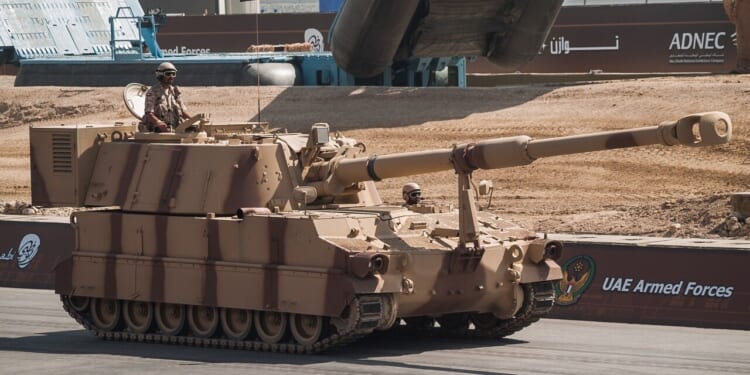If the Army doesn’t field a modern, networked, long-range, survivable self-propelled howitzer soon, it risks being totally overmatched by its peer adversaries in the next great power war.
A self-propelled howitzer (SPH) is an artillery system that combines the firepower of a traditional cannon with the mobility of an armored vehicle. Its purpose is to rain hellfire down upon an enemy position with precision and sheer explosive force.
Crucially, it moves under its own power, unlike towed artillery, which means it can “shoot and scoot”—fire off a deadly barrage, then quickly reposition before counter-battery fire can locate it. In modern warfare, where the enemy can pinpoint your location in seconds using radar and drones, that ability is key.
The Army Hasn’t Built New Self-Propelled Guns Since the 1960s
Right now, the backbone of US Army artillery is the M109 Paladin, a Cold War-era system that’s been upgraded since the 1960s. The problem is that, despite the upgrades this system has received, it remains a weapon of the 1960s. The Paladin has a range of only 18 to 24 miles. Meanwhile, China and Russia have fielded howitzers that can fire out to 43 miles or more. So, in a direct confrontation, the US Army’s artillery would die long before either China’s or Russia’s even shows up on the Americans’ radar.
What’s more, the Paladin has a glacial rate of fire when compared to some of the newer NATO systems, such as the German PzH 2000 or the South Korean K9 Thunder. That matters in a war where volume of fire wins most engagements. Plus, the M109’s armor and mobility are insufficient in an era of loitering drones and precision-guided munitions.
Many military leaders also find fault with the Paladin’s lack of networking. In today’s hyperconnected age, the battlefield has become little more than a game of competing sensors. Everything is linked on the battlefield—from airplanes, to soldiers, to drones, to artillery—and everything draws information from other sources, helping to give warfighters in all areas greater awareness. But the Paladin, coming from a bygone era, has no such connections. It complicates the ability of US forces to effectively conduct offensives in this hyperconnected battlefield.
The Army has long known it has fallen behind in this area. It has formed the Extended Range Artillery (ERCA) Program in an effort to develop a new SPH with range to match that of the newer Chinese and Russian ones. From 2018 to 2024, the Army invested resources and time into this program. But it ended in failure—and as a result, the Army remains stuck with the aging M109 Paladin for the near future.
The Army Urgently Needs a New Self-Propelled Howitzer
In the era of drones, many have reasonably asked whether SPHs are even needed. To those wondering that, it’s important to remember that drones, while certainly essential to the modern battlefield, are the equivalent of eyes and needles. Artillery is the fist.
Drones find and probe the enemy—poking when necessary. But what finishes the job in large-scale war of attrition is volume fire. With swarming tactics, drones can do major damage. But the kind of firepower that SPHs deliver is impossible to replicate with drones. In a contested environment, drones can be jammed or shot down. But no one has yet succeeded in shooting artillery shells down on a reliable basis.
Logistics matters, too. Artillery rounds are exceptionally cheap, especially compared to $100,000 (or more) missiles. If Taiwan wants to fight China on a long-term basis, or Ukraine wants to keep itself free of the Russian bear, they will need firepower that can last for weeks, not one drone strike at a time.
Russia has already proven itself capable of deploying SPHs in combat, and China is currently testing electromagnetic railguns and deploying long-range rocket artillery on artificial islands spread throughout the South China Sea (SCS). The United States, on the other hand, risks entering a great power conflict relying on systems that their grandparents would recognize. The Army’s current SPH force is good enough for counterinsurgency missions. But this type of fighting gets dramatically more difficult against enemies that can shoot back. The next fight will be with peer adversaries who come with drones, jammers, hypersonic missiles—and yes, better artillery.
Can the Army Catch Up in Artillery Production?
If the Army doesn’t field a modern, networked, long-range, survivable self-propelled howitzer soon, it risks being totally overmatched by its peer adversaries in the next great power war. Drones are transforming the battlefield, yes—but they are scouts and saboteurs. Artillery remains the king of battle.
As always, war is the ultimate fitness test for weapons. And that test always comes down to evolve or die. The longer the Americans refuse to build a new SPH for themselves, the more likely it is that their forces will die in a conflict with either China or Russia.
About the Author: Brandon J. Weichert
Brandon J. Weichert is a senior national security editor at The National Interest. Recently, Weichert became the host of The National Security Hour on America Outloud News and iHeartRadio, where he discusses national security policy every Wednesday at 8pm Eastern. He is also a contributor at Popular Mechanics and has consulted regularly with various government institutions and private organizations on geopolitical issues. Weichert’s writings have appeared in multiple publications, including The Washington Times, National Review, The American Spectator, MSN, The Asia Times, and others. His books include Winning Space: How America Remains a Superpower, Biohacked: China’s Race to Control Life, and The Shadow War: Iran’s Quest for Supremacy. His newest book, A Disaster of Our Own Making: How the West Lost Ukraine is available for purchase wherever books are sold. He can be followed via Twitter @WeTheBrandon.
Image: Shutterstock / Flying Camera.
















